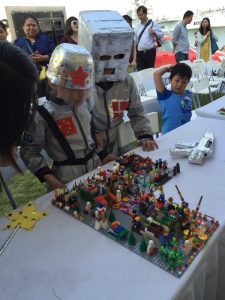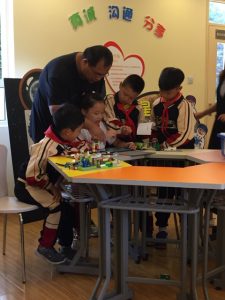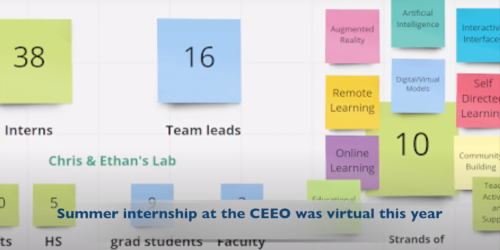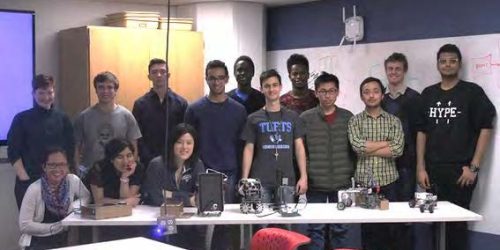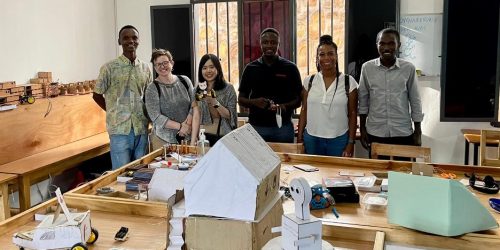by Aaron Johnson
Over the past year, the CEEO has been working with LEGO Education China to develop StoryGames – a competition for Chinese students that uses the LEGO StoryStarter set. StoryStarter is designed to be a hands-on tool for teaching literacy and language lessons. LEGO Education China and the CEEO both wanted to see how we could leverage this set to encourage science and engineering topics at the same time. In mid-October I traveled to Shanghai with Sara Willner-Giwerc, an undergraduate research assistant at the CEEO, to observe the StoryGames finals.
The CEEO’s primary role in StoryGames was to develop the challenge for students to complete. We asked students to tell us about the day in the life of a future astronaut somewhere in space. There were two separate divisions, one for students ages 6-9 and another for students ages 10-12. The younger students were asked to set their story on the Moon, and the older students were given the opportunity to choose a location in space. Older students were also allowed to create their own fictional planet, but we did not see any teams choose this option.
Students were asked to research their planet to learn about its environment and then use this knowledge to tell a story about their astronauts. All students were asked to make sure their story addressed: 1) where the astronauts get the food they eat and the water they drink, 2) what jobs the astronauts perform, and 3) what the astronauts do for fun. The older students were also encouraged to think about how their astronauts stay healthy, in shape, and protected from danger; sleep; and communicate back to earth. Students used the StoryStarter set to build scenes from their story that showed answers to these questions and were grounded in their research. They then shared the story by writing a short essay, making a video, and creating a comic with the LEGO StoryVisualizer app.
The CEEO hoped that structuring the competition challenge this way would accomplish multiple learning goals simultaneously. In doing research about a planet, students gain knowledge about the solar system and how to conduct research in books and online. And while students wouldn’t be able to construct functional engineering solutions, the grading criteria encouraged students to consider the clients and constraints in their stories. This engaged them in part of the engineering design process.
Sara and I had a chance to see how the students took up our challenge when we traveled to Shanghai to observe the StoryGames competition. It was held as a part of the annual Shanghai Modeling Festival. The older students presented their stories to a group of Chinese language teachers who judged them on their language and presentation skills. As this was occurring, Sara and I walked around and talked to the other teams about their stories. The students were all very excited about the competition and sharing their stories. A few even dressed up in homemade costumes.
In the days after the competition, we had a chance to visit a LEGO afterschool center and two elementary schools to view an example StoryStarter lesson and speak with teachers. We were really excited by our conversations with the teachers. The Shanghai Ministry of Education is encouraging project-based learning, particularly during a “flex” hour for elective classes. The teachers felt StoryGames was a successful way to incorporate LEGO and literacy into project-based learning.
We also asked teachers if they saw StoryGames as focusing more on literacy or science, and they all agreed that it contained both topics. They commented that this was one of the biggest strengths of StoryGames. As one teacher pointed out, a number of literacy competitions exist, but none of them contain a science portion. While there was enthusiasm for the science portion, a number of students’ stories had magical solutions, like a “gravity machine.” So while they were certainly responding to the needs of the astronauts, they weren’t developing realistic solutions like we had hoped. Many students, particularly the younger ones, just described their “space station” construction instead of telling a fictional story around their build.
We are currently working with LEGO Education in Billund and China to develop next year’s challenge. This challenge will focus more on the storytelling aspects while still retaining the science research at the beginning. We hope that even more students will participate next year, and we look forward to another trip to China to see what creative ideas students can come up with!

